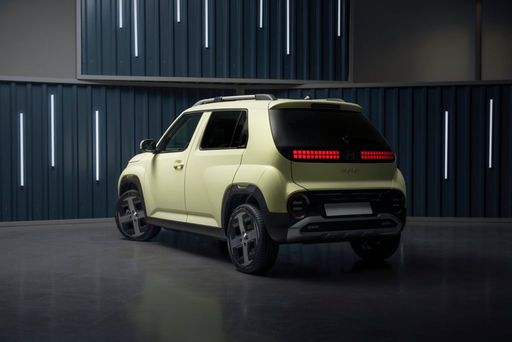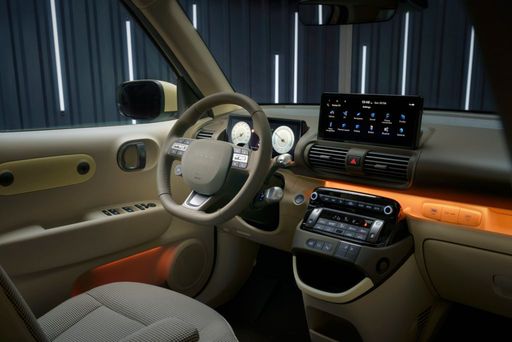Hyundai Inster vs Nissan Micra - Differences and prices compared
Costs and Efficiency:
When it comes to price and running costs, the biggest differences usually appear. This is often where you see which car fits your budget better in the long run.
Hyundai Inster has a somewhat advantage in terms of price – it starts at 20500 £, while the Nissan Micra costs 24000 £. That’s a price difference of around 3506 £.
In terms of energy consumption, the advantage goes to the Nissan Micra: with 14.20 kWh per 100 km, it’s minimal more efficient than the Hyundai Inster with 14.30 kWh. That’s a difference of about 0.10 kWh.
As for range, the Nissan Micra performs a bit better – achieving up to 416 km, about 46 km more than the Hyundai Inster.
Engine and Performance:
Under the bonnet, it becomes clear which model is tuned for sportiness and which one takes the lead when you hit the accelerator.
When it comes to engine power, the Nissan Micra has a distinct edge – offering 150 HP compared to 115 HP. That’s roughly 35 HP more horsepower.
In acceleration from 0 to 100 km/h, the Nissan Micra is distinct quicker – completing the sprint in 8 s, while the Hyundai Inster takes 10.60 s. That’s about 2.60 s faster.
In terms of top speed, the performs better – reaching , while the tops out at . The difference is around .
There’s also a difference in torque: Nissan Micra pulls distinct stronger with 245 Nm compared to 147 Nm. That’s about 98 Nm difference.
Space and Everyday Use:
Whether family car or daily driver – which one offers more room, flexibility and comfort?
Seats: Nissan Micra offers slightly more seating capacity – 5 vs 4.
In curb weight, Hyundai Inster is slight lighter – 1380 kg compared to 1452 kg. The difference is around 72 kg.
In terms of boot space, the Nissan Micra offers a bit more room – 326 L compared to 280 L. That’s a difference of about 46 L.
In maximum load capacity, the Nissan Micra performs hardly perceptible better – up to 1106 L, which is about 47 L more than the Hyundai Inster.
When it comes to payload, Nissan Micra to a small extent takes the win – 408 kg compared to 357 kg. That’s a difference of about 51 kg.
Who comes out on top?
Overall, the Nissan Micra shows itself to be dominates this comparison and secures the title of DriveDuel Champion.
It convinces with the more balanced overall package and proves to be the more versatile choice for everyday use.

Nissan Micra
Costs and Consumption
View detailed analysis
Engine and Performance
View detailed analysis
Dimensions and Body
View detailed analysis
Hyundai Inster
The Inster has quickly captured the attention of automotive enthusiasts with its striking design and dynamic performance. This model seamlessly blends advanced technology with comfort, making it an ideal choice for both daily commutes and adventurous road trips. With its spacious interior and innovative features, the Inster promises an exhilarating driving experience that doesn’t compromise on practicality.
details @ Hyundai Motor Company
@ Hyundai Motor Company
 @ Hyundai Motor Company
@ Hyundai Motor Company
 @ Hyundai Motor Company
@ Hyundai Motor Company
Nissan Micra
The Nissan Micra is a compact hatchback renowned for its agile handling and city-friendly dimensions. With a design that blends sleek curves with a practical layout, it appeals to urban drivers who value style and efficiency. Inside, the car offers a surprising amount of room and useful tech features, making it both a convenient and comfortable ride for daily commutes.
details
 @ Hyundai Motor Company
@ Hyundai Motor Company
|
|
|
|
|
Costs and Consumption |
|
|---|---|
|
Price
20500 - 25800 £
|
Price
24000 - 29900 £
|
|
Consumption L/100km
-
|
Consumption L/100km
-
|
|
Consumption kWh/100km
14.3 - 15.1 kWh
|
Consumption kWh/100km
14.2 - 14.7 kWh
|
|
Electric Range
327 - 370 km
|
Electric Range
317 - 416 km
|
|
Battery Capacity
42 - 49 kWh
|
Battery Capacity
40 - 52 kWh
|
|
co2
0 g/km
|
co2
0 g/km
|
|
Fuel tank capacity
-
|
Fuel tank capacity
-
|
Dimensions and Body |
|
|---|---|
|
Body Type
SUV
|
Body Type
Hatchback
|
|
Seats
4
|
Seats
5
|
|
Doors
5
|
Doors
5
|
|
Curb weight
1380 - 1433 kg
|
Curb weight
1452 - 1527 kg
|
|
Trunk capacity
238 - 280 L
|
Trunk capacity
326 L
|
|
Length
3825 - 3845 mm
|
Length
3974 mm
|
|
Width
1610 mm
|
Width
1774 mm
|
|
Height
1575 - 1610 mm
|
Height
1490 mm
|
|
Max trunk capacity
1059 L
|
Max trunk capacity
1106 L
|
|
Payload
317 - 357 kg
|
Payload
403 - 408 kg
|
Engine and Performance |
|
|---|---|
|
Engine Type
Electric
|
Engine Type
Electric
|
|
Transmission
Automatic
|
Transmission
Automatic
|
|
Transmission Detail
Reduction Gearbox
|
Transmission Detail
Reduction Gearbox
|
|
Drive Type
Front-Wheel Drive
|
Drive Type
Front-Wheel Drive
|
|
Power HP
97 - 115 HP
|
Power HP
122 - 150 HP
|
|
Acceleration 0-100km/h
10.6 - 11.7 s
|
Acceleration 0-100km/h
8 - 9 s
|
|
Max Speed
140 - 150 km/h
|
Max Speed
150 km/h
|
|
Torque
147 Nm
|
Torque
225 - 245 Nm
|
|
Number of Cylinders
-
|
Number of Cylinders
-
|
|
Power kW
71 - 85 kW
|
Power kW
90 - 110 kW
|
|
Engine capacity
-
|
Engine capacity
-
|
General |
|
|---|---|
|
Model Year
2025
|
Model Year
2026
|
|
CO2 Efficiency Class
A
|
CO2 Efficiency Class
A
|
|
Brand
Hyundai
|
Brand
Nissan
|
What drivetrain options does the Hyundai Inster have?
Available configurations include Front-Wheel Drive.
The prices and data displayed are estimates based on German list prices and may vary by country. This information is not legally binding.
